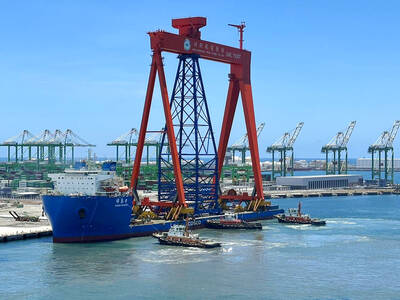At the bottom of the mountainous dunes once traversed by traders and pilgrims on the ancient Silk Road, Wang Qixiang stood with a camera draped around his neck. He was a modern-day pilgrim of sorts -- a tourist.
He and his wife had traveled by train more than 2,700km from eastern China to the forbidding emptiness of the Gobi Desert to glimpse at a famous pool of water known as Crescent Lake. They came because the lake has been rapidly shrinking into the desert sand, and they feared it might soon disappear.
"It is a miracle of the desert," said Wang, 67.

PHOTO: NY TIMES
In this desert oasis where East once met West and that is home to one of the world's greatest shrines to Buddhism, the water is disappearing. Crescent Lake has dropped more than 8m in the last three decades, while the underground water table elsewhere in the area has fallen by as much as 11m.
An ancient city that once served as China's gateway to the West, Dunhuang is now threatened by very modern demands. A dam built three decades ago to help local farming, combined with a doubling of the population, have overstressed a fragile desert hydrology that had been stable for thousands of years.
"I would call it an ecological crisis," said Zhang Mingquan, a professor at Lanzhou University who specializes in the region's hydrology. "The problem is the human impact. People are overusing the amount of water that the area can sustain."
Here, as elsewhere in western China, the country's poorest region, the emphasis in recent decades has been on economic development at all costs. Isolated by the desert, Dunhuang has virtually no industry, so agriculture has dominated the local economy. In the 1970s, the government dammed the Dang River, which once flowed past the city, to provide better irrigation for farmland and to help relieve poverty.
Farming did improve, but in a fashion that brought a larger burden: A desert oasis that had fewer than 100,000 people before the dam now has roughly 180,000. As more people arrived, the underground water table that is the city's main source of drinking water starting dropping.
The pressure now to preserve Dunhuang is amplified by the growing recognition of the city's major cultural and historic significance.
The nearby Mogao Caves, painted with murals dating to the fourth century, were built by the monks who helped bring Buddhism from India. The caves have been designated as a World Heritage Site by the UN.
The caves are a legacy of Dunhuang's emergence more than 2,000 years ago during the Han Dynasty as a crucial entrance into China by the Silk Road, which served as the principal trade route to the West. Merchants and pilgrims made the journey by following the string of oases that skirted the brutal Taklamakan Desert, which many considered haunted by demons and ghosts.
"At times one can hear coughing, or sobbing, but suddenly one does not know where to turn. Thus many perish," the famous seventh-century Chinese monk Xuanzang wrote of the voices he heard in the brutal heat. He described the desert as so bleak and empty that travelers stacked up bones as landmarks.
Farming in Dunhuang also dates to the Han Dynasty, and among the tens of thousands of manuscripts found inside the Mogao Caves was a map that detailed the region's critical water sources. Now, in the village of Zhabacha, about 10km north of the city center, the water table has dropped more than 1.5m in the past five years alone.
Beneath a midday sun last Tuesday that had driven other farmers into their crumbling adobe homes, He Zhailin flooded a small plot of wheat with water. He said he has tripled his amount of cultivated land during the past decade and that some farmers had expanded even more. Until recently, he said, government officials had encouraged farmers to plant more crops.
"There was a lot of water, so the government encouraged people to cultivate the land," recalled He, 40. "At the time, it never dried up."
Now, local officials have introduced a strict policy known as the "Three Forbids" that bans any new farmland, forbids new migrants from moving to the city and prohibits any new wells. The need to protect the underground water is magnified by the fact that almost 90 percent of water from the Dang Reservoir is dedicated to agriculture.
Zhang, the Lanzhou University professor, stressed that reducing consumption is the problem and noted that the supply of glacial melt from the Qilian Mountains that feeds the Dang River -- and by extension the rest of the oasis -- remains largely unchanged from centuries ago. Even so, there are proposals to divert water from a river in adjacent Tibet, though the likelihood of such a plan is far from certain.
Conservation has become particularly critical because Dunhuang has emerged as one of the leading tourist attractions in western China, giving the city a veneer of prosperity rare in rural regions. Last year, more than 430,000 tickets were sold to the Mogao Caves. In all likelihood, even more people visited Crescent Lake, which is nestled in the picturesque dunes known as the Singing Sands.
The lake, also a World Heritage Site, began shrinking in the 1970s and is now about a third of its original size. In the 1990s, officials tried pumping in water but quit because the transfers were polluting the lake. More recently, reservoirs have been built a short distance away in hopes that water would seep into the ground and help Crescent Lake.
"As local people, we are very worried," said Fan Cun, who heads the agency overseeing the lake. "We would have failed future generations if we watch this lake disappear."

The canonical shot of an East Asian city is a night skyline studded with towering apartment and office buildings, bright with neon and plastic signage, a landscape of energy and modernity. Another classic image is the same city seen from above, in which identical apartment towers march across the city, spilling out over nearby geography, like stylized soldiers colonizing new territory in a board game. Densely populated dynamic conurbations of money, technological innovation and convenience, it is hard to see the cities of East Asia as what they truly are: necropolises. Why is this? The East Asian development model, with

June 16 to June 22 The following flyer appeared on the streets of Hsinchu on June 12, 1895: “Taipei has already fallen to the Japanese barbarians, who have brought great misery to our land and people. We heard that the Japanese occupiers will tax our gardens, our houses, our bodies, and even our chickens, dogs, cows and pigs. They wear their hair wild, carve their teeth, tattoo their foreheads, wear strange clothes and speak a strange language. How can we be ruled by such people?” Posted by civilian militia leader Wu Tang-hsing (吳湯興), it was a call to arms to retake

This is a deeply unsettling period in Taiwan. Uncertainties are everywhere while everyone waits for a small army of other shoes to drop on nearly every front. During challenging times, interesting political changes can happen, yet all three major political parties are beset with scandals, strife and self-inflicted wounds. As the ruling party, the Democratic Progressive Party (DPP) is held accountable for not only the challenges to the party, but also the nation. Taiwan is geopolitically and economically under threat. Domestically, the administration is under siege by the opposition-controlled legislature and growing discontent with what opponents characterize as arrogant, autocratic

When Lisa, 20, laces into her ultra-high heels for her shift at a strip club in Ukraine’s Kharkiv, she knows that aside from dancing, she will have to comfort traumatized soldiers. Since Russia’s 2022 invasion, exhausted troops are the main clientele of the Flash Dancers club in the center of the northeastern city, just 20 kilometers from Russian forces. For some customers, it provides an “escape” from the war, said Valerya Zavatska — a 25-year-old law graduate who runs the club with her mother, an ex-dancer. But many are not there just for the show. They “want to talk about what hurts,” she